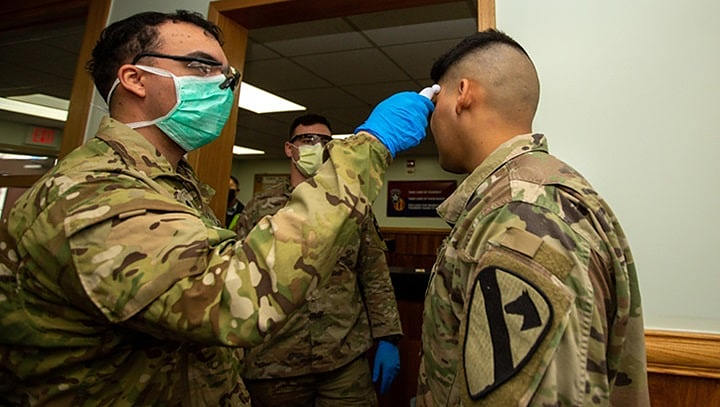Coronavirus Exit Strategy: Three critical factors to watch and how they impact currencies
- The coronavirus has reached a stage where governments are beginning to contemplate exit strategies.
- Pressure on health systems is critical to lockdowns and easing them.
- Widespread COVID-19 testing and sophisticated contact tracing are crucial to controlling new outbreaks.

When can we get out of the house? That is the question on the minds of around half the world's population that is shut down at home. The broad lockdowns have also kept millions out of work and triggered a mass cancelation of activities, causing substantial economic damage.
Governments issued stay-at-home orders to slow the spread of coronavirus, "flatten the curve" – and ease pressure on health systems. The fear – materialized in some places – was that there would be insufficient staff and equipment to deal with the influx of COVID-19 cases.
On the economic front, authorities have offered fiscal and monetary stimulus to mitigate the fallout – help businesses survive, those losing their jobs to get by, and potentially keep as many people in work as possible.
After long weeks of agony, there is light at the end of the tunnel in several places. Italy has seen a fall in new cases and deaths, Spain has experienced a substantial deceleration and Andrew Cuomo – the grim Governor of New York – is also somewhat more optimistic.
Policymakers are now beginning to consider taking initial steps to remove restrictions, ease the "cabin fever" and kickstart the economies. The faster the return to normal – the better for the underlying currencies. However, any easing will likely be gradual, to avoid a fresh outbreak and reversion to stricter limits.
Such setbacks would be more devastating than a slower lockdown relaxation, as they would undermine the public confidence and investors' animal spirits. To unleash the economy, governments would rely on three pillars:
1) Lower UCI utilization
The main motive of shutdowns is to slow the rush into hospitals and especially Intensive Care Units. People admitted to ICUs require more human resources and equipment, such as ventilators of various kinds.
A significant drop in UCI utilization may come via fewer severe cases of COVID-19 and also by increasing capacity, such as field hospitals such as Britain's Nightingale ones Madrid's Ifema, or New York's Javits center transformation into one big ICU.
It is essential to note that the coronavirus infection rate is rapid and should be with the exponential rate of increase, indicating that 50% UCI use may be insufficient as beds may fill up quickly. A usage rate of 25% would allow a broader margin for governments to take a calculated risk and allow people to move more freely.
2) Higher testing capacity
South Korea successfully halted the spread of the virus by widespread testing of the population in drive-throughs and other places. That allowed the Asian nation to refrain from a nationwide lockdown.
A country that deploys a vast system of coronavirus analysis – including for antibodies and not only for identifying sick people – would be able to open up the economy faster than others.
Extensive testing also allows finding many asymptomatic cases, therefore lowering the death rate and boosting confidence in the population.
3) Automatic contact tracing
Apart from quick and efficient testing, the key to opening up – and potentially imposing localized shutdowns – is contact tracing. Each newly discovered infected person ran into others on their way. Interviewing that person may lead to several contacts, but perhaps not to all of them, and it may be more limited if the person is unconscious.
It would be easier to unleash activity if there would be a widespread automatic tracing of people via cellphone applications. Some countries have already deployed such mobile apps voluntarily. Others, such as Israel, are using emergency laws to track people infected with the disease or those that have been in touch with potentially affected people.
The stronger these capabilities become, the faster lockdowns may be relieved.
Currency behavior
Eurozone countries have suffered most of the global deaths, and every improvement in these three fields may fasten the opening up of the economy and boost the euro. The UK is behind on several factors, but the impact will likely be straightforward for the pound.
The US dollar, and especially the Japanese yen, are safe-haven currencies and have different behavior. They may lose ground in response to the good news. If the US eases nears easing restrictions, investors may abandon the safety of the greenback and move to currencies deemed riskier. Conversely, any setback in the US may lead to traders clinging onto the dollar.
Conclusion
The battle against coronavirus is nearing the end of the beginning, and it is time to look at exit strategies. ICU utilization, widespread testing, and tracing capabilities are critical to easing lockdowns and restarting the economies – therefore, essential for currencies.
Author

Yohay Elam
FXStreet
Yohay is in Forex since 2008 when he founded Forex Crunch, a blog crafted in his free time that turned into a fully-fledged currency website later sold to Finixio.

















